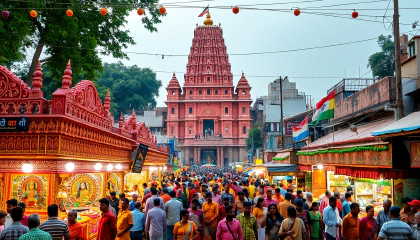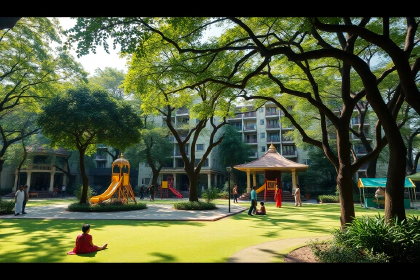
Chittaranjan Park: Delhi's Bengali Cultural Haven
Exploring the Cultural Richness and Accessibility of Chittaranjan Park: Delhi’s Little Bengal
Nestled in the heart of South Delhi, Chittaranjan Park (CR Park) stands as a vibrant testament to the city’s multicultural fabric. This unique neighborhood, often referred to as “Little Bengal,” offers a fascinating blend of Bengali culture, modern urban living, and historical significance. From its origins as a refugee resettlement area to its current status as a sought-after residential locale, CR Park has evolved into a cultural hub that attracts both residents and visitors alike. This article delves into the multifaceted aspects of Chittaranjan Park, exploring its rich heritage, cultural landmarks, and its role in Delhi’s diverse landscape.
Historical Roots and Cultural Significance
From Refugee Colony to Cultural Enclave
Chittarajan Park’s story begins in the aftermath of India’s partition. Originally known as the East Pakistan Displaced Persons (EPDP) Colony, it was established in the early 1960s to accommodate refugees from East Bengal (now Bangladesh). The area was later renamed in honor of the Bengali freedom fighter Chittaranjan Das, reflecting its deep connection to Bengali heritage.
A Hub of Bengali Culture in Delhi
Over the decades, CR Park has transformed into a thriving center of Bengali culture in the capital. The neighborhood’s streets come alive during festivals like Durga Puja, with magnificent pandals (temporary structures) and vibrant celebrations that attract thousands of visitors. The area’s cultural institutions, such as the Chittaranjan Park Bangiya Samaj and the Deshbandhu Chittaranjan Memorial Society, play a crucial role in preserving and promoting Bengali arts, literature, and traditions.
Architectural Landscape and Urban Planning
Residential Blocks and Community Spaces
CR Park’s layout reflects a thoughtful urban planning approach, with alphabetically named blocks (A to K) and additional pockets. Each block features a mix of traditional Bengali-style homes and modern multi-story apartments. The neighborhood’s numerous parks, including the central Mela Ground, serve as crucial community spaces for recreation and social gatherings.
Landmarks and Institutions
The area boasts several significant landmarks that contribute to its unique character:
- Kali Mandir: This prominent temple complex is a focal point for religious and cultural activities.
- Raisina Bengali School: Established in the 1970s, it plays a vital role in preserving Bengali language and culture among younger generations.
- Markets: CR Park’s four main markets are bustling hubs of activity, offering everything from fresh fish to traditional Bengali sweets.
Culinary Delights and Street Food Culture
A Gastronomic Paradise
One of CR Park’s most enticing features is its rich culinary scene. The neighborhood’s streets are lined with food stalls and restaurants offering authentic Bengali cuisine. Visitors can savor delicacies such as:
- Phuchka (pani puri)
- Jhalmuri (spiced puffed rice)
- Kosha mangsho (Bengali-style mutton curry)
- Mishti doi (sweet yogurt)
These culinary offerings not only satisfy taste buds but also serve as a cultural bridge, introducing Delhi’s diverse population to the flavors of Bengal.
Accessibility and Modern Development
Strategic Location and Connectivity
Chittaranjan Park’s desirability is further enhanced by its strategic location and excellent connectivity:
- Proximity to major transportation hubs: The Indira Gandhi International Airport is approximately 17-23 km away, while New Delhi Railway Station is about 16 km from the neighborhood.
- Metro connectivity: The area is served by multiple Delhi Metro stations, including Nehru Place on the Violet Line and Greater Kailash on the Magenta Line, both within a kilometer of key CR Park blocks.
- Surrounding areas: CR Park is bordered by popular localities such as Greater Kailash, Kalkaji, and Nehru Place, offering residents easy access to commercial centers and entertainment options.
Real Estate and Development
As South Delhi’s property market continues to boom, CR Park has seen significant appreciation in real estate values. The neighborhood’s unique cultural character, combined with its modern amenities and strategic location, makes it an attractive option for both homebuyers and investors.
Conclusion: A Microcosm of Cultural Integration
Chittaranjan Park stands as a shining example of how cultural identity can be preserved and celebrated within the context of a rapidly evolving urban landscape. Its journey from a refugee resettlement to a thriving cultural enclave offers valuable insights into the dynamics of community-building and urban development.
As Delhi continues to grow and change, CR Park remains a testament to the city’s ability to embrace diversity and create spaces where tradition and modernity coexist harmoniously. For residents, visitors, and culture enthusiasts alike, Chittaranjan Park offers a unique window into the rich tapestry of Bengali heritage, right in the heart of India’s capital.





